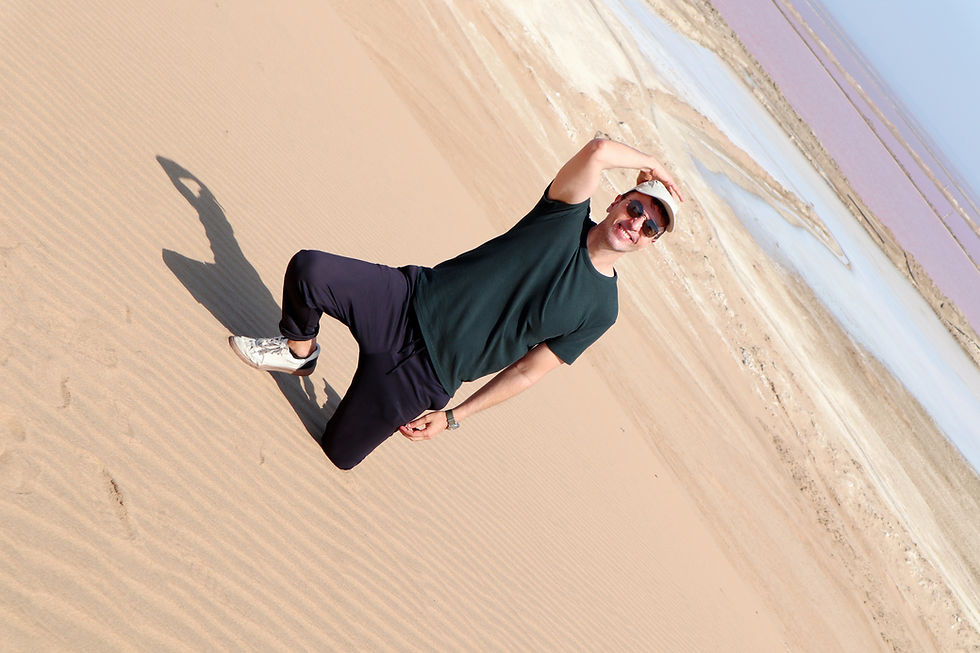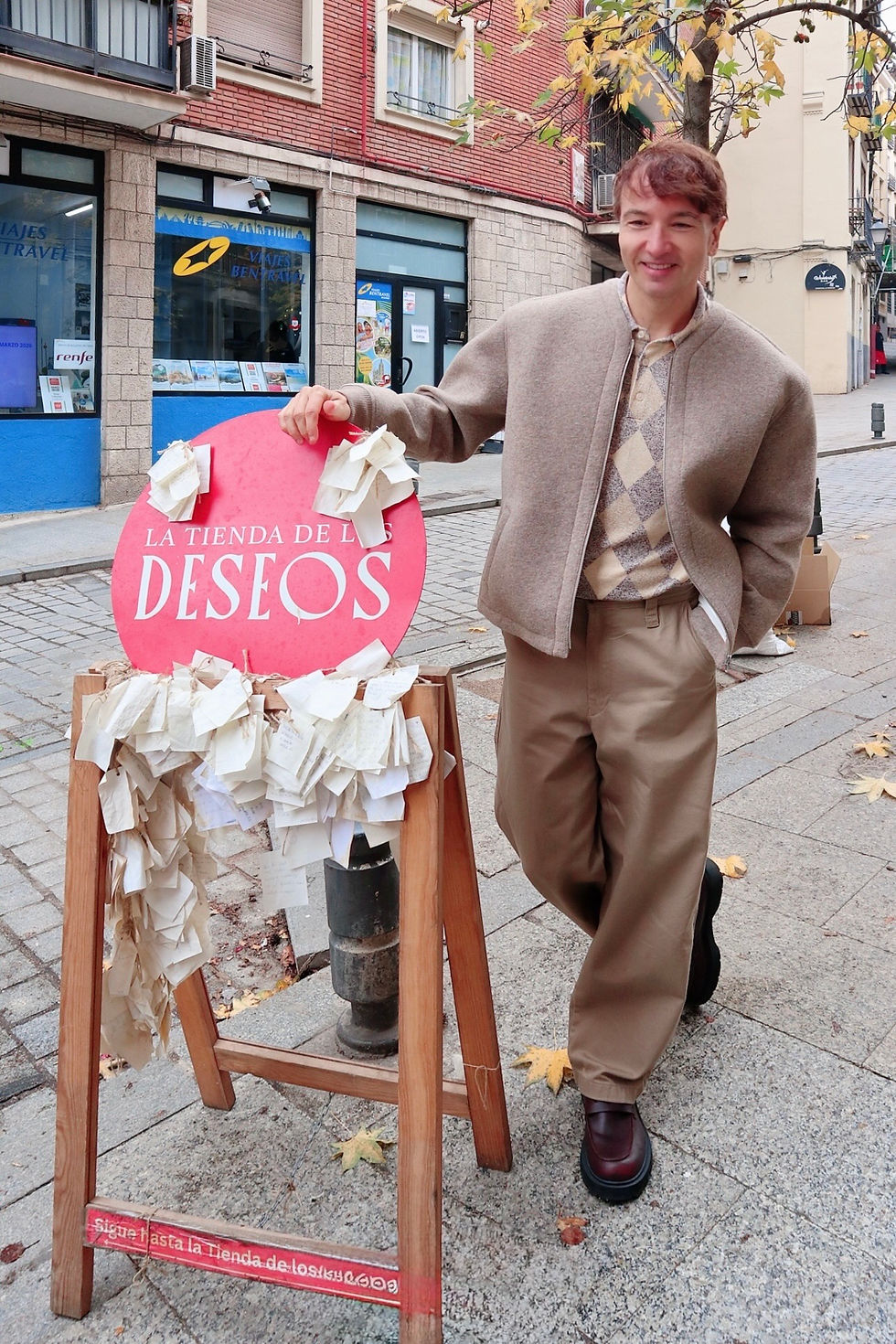SWAKOPMUND, UN TROZO DE ALEMANIA EN NAMIBIA
- The Trendy Man

- 11 ago 2021
- 5 Min. de lectura
Actualizado: 19 abr 2023

Lo primero que llama la atención al entrar en Swakopmund después de atravesar cientos de kilómetros de carreteras de gravilla y tierra es la quietud. LLegas sudoroso y polvoriento de atravesar casi en soledad el desierto hasta aquí y, de repente, el paisaje cambia por completo. La carretera se asfalta, aparecen cientos de coches, hay semáforos, tiendas, supermercados y casitas, muchas casitas bajas de inspiración europea que te dicen que has llegado al que fue el primer asentamiento alemán cuando Namibia formaba parte del imperio germano.
Swakopmund no sólo guarda ese halo de colonia alemana sino que parece estar orgullosa de su pasado. De hecho aún están en pie (y funcionando) todas los edificios y estructuras que construyeron; como la iglesia luterana, la estación de tren (ahora hotel), el muelle de carga, escuelas, hospitales, zonas ajardinadas...más parece una ciudad báltica que namibia. Y, aunque parezca contradictorio, ese es su principal encanto.
Ese y la bruma. Una espesa bruma que viene directamente de las profundidades del Atlántico, se mete en pleno desierto del Namib y que engulle toda la ciudad dándole al anochecer un aspecto fantasmagórico, como si estuvieras en el Londres del siglo XIX.
Todo esto, y mucho más, es Swakodmund.
Bienvenidos.
The first thing that catches your attention when you enter Swakopmund after hundreds of kilometers of gravel and dirt roads is the stillness. As you arrive sweaty and dusty from crossing the desert almost in solitude to get here, suddenly, the road becomes paved, hundreds of cars show up, there are traffic lights, stores, supermarkets and small houses, many low houses European-inspired telling you that you have arrived to what was the first German settlement when Namibia was part of the German Empire.
Swakopmund not only keeps that aura of German colony but seems to be proud of its past. In fact, all the buildings and structures they built are still standing (and working), such as the Lutheran church, the train station (now a hotel), the loading dock, schools, hospitals, gardens... it looks more like a Baltic city than a Namibian one. And, although it may seem contradictory, that is its main charm.
That and the haze. A thick mist that comes directly from the deep Atlantic, gets into the Namib Desert and swallows the whole city giving it a ghostly appearance in the evening, like being in the 19th century London.
Swakodmund is all this and much more.
Welcome to the city.




Para bien o para mal la historia de Swakopmund es la típica de cualquier ciudad colonial. La diferencia es que ellos han sabido reinventarse y, lejos de buscar revanchas, han sacado provecho de su pasado alemán y ahora la ciudad es centro turístico de esta parte de África.
Swakopmund fue fundada en 1892 por el capitán Curt von François, debido al creciente tráfico entre Alemania y su colonia África del Sudoeste Alemana ya que el único puerto existente, el de Walvis Bay, situado 33 kilómetros más al sur, era posesión del Reino Unido.
Swakopmund creció rápidamente al ser el principal puerto de todo el territorio y recibió el estatus de municipio en 1909. Muchas compañías de exportación e importación abrieron agencias en la ciudad. Después de la Primera Guerra Mundial todas las actividades fueron trasferidas a Walvis Bay, con lo que muchas empresas cerraron y la población disminuyó rápidamente.
A finales del siglo XX la ciudad ha visto resurgir su economía debido al incremento del turismo.
Ahora, sin duda, es el mejor paisaje urbano de Namibia con un auténtico festín de arquitectura art-nouveau que parece el escenario de una película de Hollywood.
Swakopmund's history, either for better or for worse, is like any other colonial city. The difference here lies in the fact that they have managed to re-invent themselves and, far from seeking revenge, they have taken advantage of their German past and now the city is the tourist center of this part of Africa.
Swakopmund was founded in 1892 by Captain Curt von François, due to the growing traffic between Germany and its colony of German South West Africa, since the only existing port, that of Walvis Bay, located 33 kilometers further south, was in the possession of the United Kingdom.
Swakopmund grew rapidly as it became the main port for the entire territory and received the status of a municipality in 1909. Many export and import companies opened agencies in the city. After World War I all activities were transferred to Walvis Bay, so many companies closed and the population declined rapidly.
At the end of the 20th century the city has seen a resurgence of its economy due to the increase of tourism.
Now, no doubt, it is the best cityscape in Namibia with a real feast of art-nouveau architecture that looks like the set of a Hollywood movie.





Como os dije antes Swakopmund se ha convertido en capital del turismo de aventuras en esta zona de África. Son miles los turistas que año tras año vienen hasta aquí para disfrutar de las numerosas actividades que te ofrece todo este maravilloso paraje natural, único en el mundo.
Si, aparte de ver edificios coloniales y beber cerveza alemana, quieres subir tu nivel de adrenalina puedes tirarte en paracaídas, correr en quads por las dunas del desierto, surfear en la arena o pescar en la costa. También puedes hacer excursiones hacia el desierto, paseos en catamarán para avistar ballenas y focas o, mi preferido, recorrer las dunas de arriba abajo como en una montaña rusa en un 4x4 conducido por expertos.
Creedme, la experiencia es única. Estar en lo alto de las dunas y bajar en picado una altura de más de 700 metros de arena fina es algo que jamás se me olvidará.
Para acabar la jornada una maravillosa comida con champagne sudáfricano para brindar por ese maravilloso día. ¿A qué es fantástico?
As I mentioned before, Swakopmund has become the capital of adventure tourism in this part of Africa. Thousands of tourists come here every year to enjoy all the activities that this wonderful natural landscape, unique in the world, can offer you.
If, apart from seeing colonial buildings and drinking German beer, you want to increase your adrenaline level, you can go skydiving, quad biking in the desert dunes, surfing in the sand or fishing off the coast. You can also take excursions into the desert, catamaran rides to spot whales and seals or, my favorite, ride up and down the dunes like a roller coaster in a 4x4 driven by experts.
Believe me, the experience is unique. Being at the top of the dunes and plummeting down a height of more than 700 meters of fine sand is something I will never forget.
To finish the day a wonderful meal with South African champagne to toast to this wonderful day. Isn't it fantastic?





Ah, una última cosa. Toda esa zona está repleta de barcos abandonados, la llaman la Costa de los Esqueletos. Es fácil encontrarse con uno de estos fantasmagóricos buques que han naufragado en estas traicioneras aguas y se han quedado allí para siempre. La imagen de las olas rompiendo sin cesar contra restos de madera y hierro, sin otro sonido que el rumor del mar, resulta sobrecogedora.
¿La mejor temporada para venir? Sin duda los meses de julio y agosto. Es su invierno y las temperaturas máximas no superan los 27 grados, algo parecido a nuestra primavera.
Disfrutad mucho.
Oh, one last thing. This entire area is full of wrecked ships, they call it the Skeleton Coast. It is easy to come across one of these ghostly ships that have been wrecked in these treacherous waters and left there forever. The image of the waves crashing endlessly against the wreckage of wood and iron, with no sound other than the murmur of the sea, is breathtaking.
The best time to come? Undoubtedly the months of July and August. It is winter and the maximum temperatures do not exceed 27 Celsius degrees, something similar to our spring.
Please enjoy it very much.

Llevo puesta una camiseta de COS, pantalón de chandal de MANGO y sneakers también de MANGO.
I'm wearing a COS T-shirt, MANGO jogging pants and MANGO sneakers as well.






Comentarios